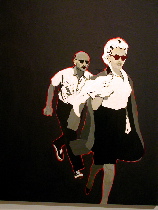
Rosalyn Drexler, an artist whose edgy pop paintings were included in several important shows of pop art in the 1960s, is someone you probably haven’t heard much about. (top image is “Marilyn Pursued by Death” 1967)
That’s because while the careers of her peers, artists like Alex Katz, Claes Oldenberg, and Roy Lichtenstein, (whom you know) were taking off, Drexler, who was young and married and raising a daughter — didn’t have a clue about managing her career. (image below “Is it true what they say about Dixie,” 1966)
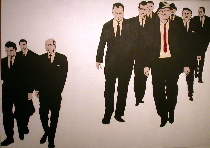
And as a self-taught artist, coming up outside the system and having no mentors and promoters to help her cut deals and win gallery assignments, she wasn’t picked up by a gallery.
There was also that little problem of the artist being a woman in a field dominated by men. Or, as Drexler put it when we talked by phone Wednesday, “Women were not bankable at the time.”
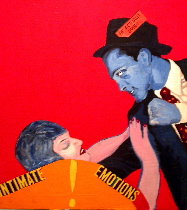
I suppose there’s also the fact that her work — darker and more prickly and more pointed politically than some of her contemporaries, (i.e. Katz in particular) — might have been a hard sell. Drexler’s themes — violence against women; the brutality of boxing; the media’s unstinting focus on celebrities — don’t make pretty wall candy. (image above “Intimate Emotions,” 1963)
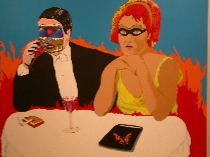
Right now, courtesy of Curator (and artblog contributor) Sid Sachs — who has a solid history of introducing — or re-introducing to the public — women artists whose works are under the radar (previous shows of Ree Morton and Yvonne Rainer, for example) — has brought a group of Drexler’s big, bold, muscular collage paintings to Rosenwald Wolf Gallery, in an exhibit called “To Smithereens.” (image above is “Last Call,” 1985)
Run, don’t walk to this show.
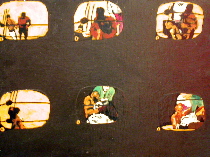
Drexler’s works, with their saturated color their high-contrast figuration and their political themes are as fresh as today. Fresher, even. And get a load of her techniques — she was a collage artist who selected images from newspapers and magazines, then had them blown up (this is pre-Kinkos, remember), and glued them to the canvas, painting right on top of them (she was the first to try this, and as a technique it’s effective — the works feel painted, yet you can see their paper cut-out underpinnings — it’s a nice juxtaposition). She was also the first to make paintings based on sequential images from the television screen.
It is in fact shocking how contemporary these works feel. (image above is “Death of Benny “kid” Paret” 1963, a fight in which a boxer dies in the ring and it’s captured live on tv. Image below is “The Bite,” 1963)
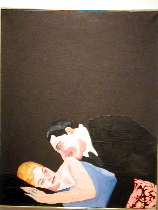
In a wonderful brochure essay, former MOMA Curator, now NYU Professor Robert Storr compares Drexler’s hard-boiled, noir-ish paintings to the “brooding, maverick sensibilities..[of]Raymond Pettibon.” You may want to think about Drexler as you look at Pettibon’s great room installation in the Whitney Biennial (image below is detail from Pettibon’s “Piecemeal Kingdom” wall). In fact think about Drexler in comparison with any young artist in that show. Her work is stronger than the lot of em.
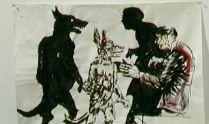
Drexler told me many stories about her works like how she merged art and life in “Art History: Ana Falling” 1989 (above) which merges Ana Mendiata’s fall from a New York building with an image from a news story about another woman who fell from a fire escape. (image bottom)
She told me of her friendship with Andy Warhol and how he helped her pack her bags for Europe (he made her take evening gowns…just in case) and about the time she posed for George Segal (she is the woman in the dry cleaning store installation). I’ll post the interview when I get it transcribed.
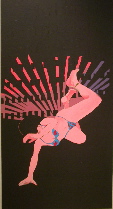
But mostly, I want to encourage you to go see the works and think of them in terms of today’s painting. Drexler’s works are better than any paintings I saw at the Biennial. They are unblinking in their ability to communicate about an off-kilter world where the status quo sucks.
Drexler, who is also a credentialed writer with several novels, four Obies and an Emmy award to her name (she was a writer for a famous Lily Tomlin special that won the Emmy) will read from one of her works on April 14 at 6 p.m. at the Gershman Y, 411 S. Broad St.
Read Michael Duncan‘s Art in America review of Drexler’s 2000 show at Mitchell Algus and Nicholas Davies.









